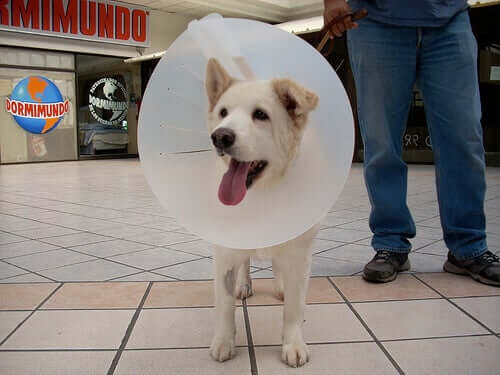Alternatives to Pet Cones For Dogs

Pet cones, Elizabethan collars, E-collars, Buster collars and the “cone of shame” all refer to the same thing. It’s an element placed around a dog’s neck to keep him from biting, licking, or injuring a certain part of their bodies. It’s especially common for veterinarians to recommend dog cones after an operation or veterinary treatment. Even though their purpose is to protect pets, dogs often find them to be quite a nuisance. So, in today’s article, we want to suggest several alternatives to pet cones for dogs.
What is a pet cone?
Basically, pet cones are a tool that pet health professionals place on a dog’s neck after surgery or an accident that has involved stitches. Dogs can reach almost any part of their bodies with their snouts. So, after they’ve had an operation, it’s normal for them to try to pull out their stitches. They do so in an attempt to heal the wound themselves. And, of course, because the area may feel painful, itchy or just plain uncomfortable.
In order to keep dogs from licking, biting or scratching, the pet cone was invented. The principle objective is to keep animals from injuring themselves or causing infection.

The problem with “the cone of shame” is that it’s very awkward and uncomfortable for animals. Therefore, they all do whatever they can to take them off. What’s more, when dogs are wearing a pet cone, they probably won’t want to walk, and will likely run into furniture, walls, and people when they do. What’s more, dogs often become depressed, growl, refuse to eat and drink, show their teeth when someone approaches, and so on while wearing a pet cone.
Before discussing alternatives to pet cones, we’d like to give you some advice. If a veterinarian has placed one of these devices on your dog…
- Encourage your dog to walk. Stand in front of him where he can see you and guide him.
- Allow your dog to move freely around every corner of your home in order to get used to the collar.
- Try to remove any objects that could hurt your dog.
- Don’t ever try to put your hand inside the cone without your dog seeing you first.
- Elevate food and water bowls (onto a small bench, for example) so your dog has better access to them.
- Make sure that the pet cone is not to tight on your dog’s skin. This may impede your dog from eating, drinking and breathing normally.
- Give him a small pillow so that he can sleep more comfortably.
Alternatives to pet cones you may be interested in
In some cases, owners do everything they possibly can to make their pets comfortable, but they still try to remove the cone. If that’s your case, here are some alternatives to pet cones:
1. T-shirt
This alternative is helpful in the case of minor wounds on a dog’s front legs. You don’t have to buy anything. Just grab an old t-shirt you no longer use and tie the sleeves around his waist. If the wound or surgery is on his abdomen, then you should use a long-sleeved shirt and tie it around his chest.
For wounds on a dog’s hindquarters, place a shirt on him backwards. In other words, put his back legs through the sleeves, and his tail through the collar. If you use this option, make sure you remove the shirt when you take your dog outdoors. Otherwise, it will act as a diaper and your dog won’t be able to take care of his needs.
2. Socks
Another excellent alternative to pet cones when dogs have wounds on their back legs is to use a sock. This way, your dog can’t easily access his legs to bite or injure himself. Make sure the sock’s elastic adjusts well so that it doesn’t fall off. You can use a rubber band just in case–just be sure it’s not so tight that it cuts off your dog’s circulation.
3. “Comfortable” collars
One of the problems with pet ones is that they are uncomfortable. The good news is that pet stores sell a cushioned version that is more comfortable. When your dog or cat wants to lay down, he won’t have hard plastic on his neck, but rather a soft pillow.

4. Inflatable and cervical collars
Inflatable collars are similar to those we use in planes to sleep–but circular. They allow animals to maintain their peripheral vision but keep them from accessing wounds to bite or lick them. Another option is to use a cervical collar, which keeps them from moving their neck around as freely.
Main image courtesy of Victor Pineda.
All cited sources were thoroughly reviewed by our team to ensure their quality, reliability, currency, and validity. The bibliography of this article was considered reliable and of academic or scientific accuracy.
- 7 Alternatives to the “Cone of Shame”, Trupanion. Recogido a 20 de enero en https://trupanion.com/blogs/7-alternatives-cone-shame